Whether you’re building raised beds and decks to grow the things you love or learning to love your existing situation by making rain gardens draped with ferns and mosses, fall is the ideal time to give your saturated Gainesville landscape a dazzling makeover. Here are 10 ways to do just that.
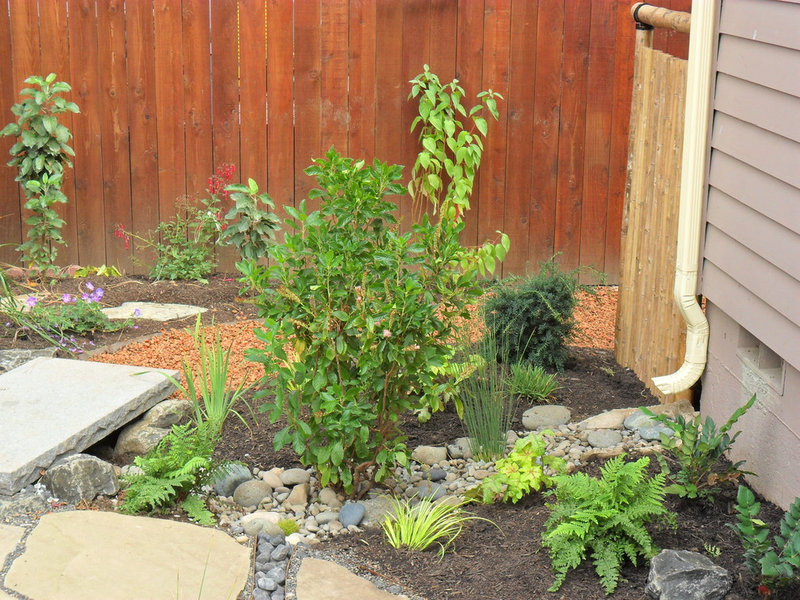 Plan-it Earth Design
When we were children, the combination of water and dirt held endless possibilities and hours of enjoyment. It didn’t matter if the two ingredients conspired to form a mud puddle, a ditch or the mother lode: a gurgling brook in the woods. There’s something about moving water that still captivates us to this day.
Plan-it Earth Design
When we were children, the combination of water and dirt held endless possibilities and hours of enjoyment. It didn’t matter if the two ingredients conspired to form a mud puddle, a ditch or the mother lode: a gurgling brook in the woods. There’s something about moving water that still captivates us to this day. For those of us with the “problem” of having too much water, we have the opportunity to channel it into man-made streambeds of rocks, gravel, moss and plants that leave the surrounding Gainesville lawn high and dry.
The difference between a mere ditch and a rain garden comes down mostly to the amount of foresight and artistry that you invest in the project. A ditch (also called a swale) is nothing more than a trench dug in the dirt that collects excess water and ushers it away from the house. Unfortunately, ditches are often either choked with weeds, covered in mud or robbed of their soil through erosion.
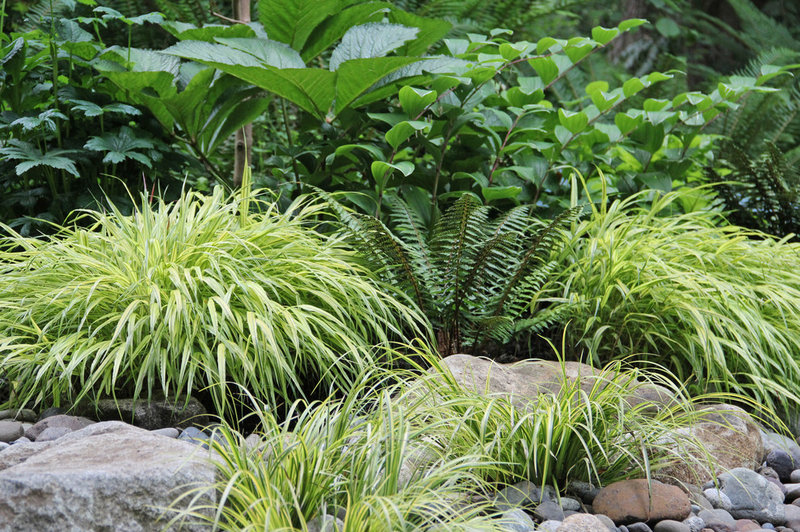 Bliss Garden Design
1. Make a rain garden. That’s where rain gardens come in handy. All it takes to turn an ugly ditch into a rain garden is replacing the grass and weeds with moisture-tolerant plants, rocks and gravel to create a naturalistic-looking stream bed. There will be weeding (as is the case with most gardens), but the gravel and stones will do their part to inhibit weed growth.
Bliss Garden Design
1. Make a rain garden. That’s where rain gardens come in handy. All it takes to turn an ugly ditch into a rain garden is replacing the grass and weeds with moisture-tolerant plants, rocks and gravel to create a naturalistic-looking stream bed. There will be weeding (as is the case with most gardens), but the gravel and stones will do their part to inhibit weed growth.The first step is deciding where the water will end up, with downhill being the most obvious answer. Avoid directing water onto another person’s property, as it is an easy way to get on your neighbor’s bad side and end up with a hefty fine in the process. If you have the space, direct the flow of water to a low-lying area of the yard where water typically collects. Then plant that area with perennials and shrubs that can tolerate standing water.
To make the rain garden appear more natural, follow the contours of the land and vary the width of the streambed occasionally. Plant larger accent plants along the edge of the bed where it curves.
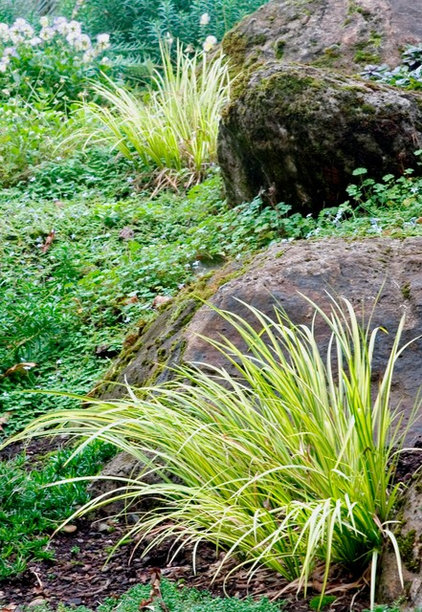 Monrovia
2. Choose plants that can handle having wet feet. Even if you don’t plant a rain garden, the easiest and most direct option is to use plants that will actually thrive in your conditions. They might be a little harder to find than drought-tolerant plants, but there are lots of possibilities if you know what you’re looking for.
Monrovia
2. Choose plants that can handle having wet feet. Even if you don’t plant a rain garden, the easiest and most direct option is to use plants that will actually thrive in your conditions. They might be a little harder to find than drought-tolerant plants, but there are lots of possibilities if you know what you’re looking for. Replace your drowning lawn with moisture-loving ground covers like Evergold sedge (Carex oshimensis ‘Evergold’, USDA zones 5 to 11), sweet grass (Acorus gramineus, zones 6 to 9), spiderwort(Tradescantia virginiana, zones 5 to 10) andspikemoss (Selaginella spp, zones vary). Shrubs like Florida anise (Illicium floridanum, zones 7 to 10), Southern wax myrtle (Myrica cerifera, zones 7 to 10) and hollies (Ilex spp, zones vary) are good choices where height is needed. I’ve also written an ideabook detailing some of the native trees that can stand up to flooding.
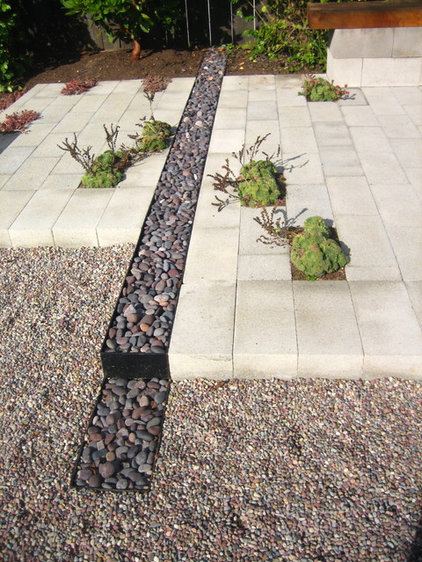 Terra Ferma Landscapes
3. Install a Gainesville French drain. If a rain garden just isn’t right for your lifestyle or the layout of your landscape, a French drain might be the way to go. A French drain is essentially a perforated tube that collects water and distributes it away from a building or poorly drained area. It may be buried in decorative rocks or gravel when used within hardscaping, such as a patio or walkway, or if it needs to travel through the landscape, it may be topped with turf or ground covers to efficiently drain the area without even being visible.
Terra Ferma Landscapes
3. Install a Gainesville French drain. If a rain garden just isn’t right for your lifestyle or the layout of your landscape, a French drain might be the way to go. A French drain is essentially a perforated tube that collects water and distributes it away from a building or poorly drained area. It may be buried in decorative rocks or gravel when used within hardscaping, such as a patio or walkway, or if it needs to travel through the landscape, it may be topped with turf or ground covers to efficiently drain the area without even being visible. The downside of Gainesville drainage system is that while rain gardens slow the path of water and absorb it along with fertilizer and pollutants, a French drain sends it off the property and into the watershed.
Using the two in tandem is another option. A French drain can open up to a rain garden where the water is absorbed, or it can sit at the end of a rain garden to prevent flooding. If possible, work with a landscape architect to determine the best system for your situation.
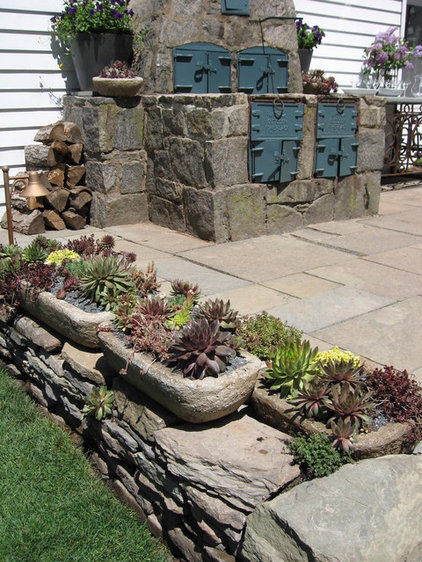 Susan Cohan, APLD
4. Create a killer container garden. If you want to grow vegetables or one of the many other plants that require well-drained soil, planting them in containers along with potting mix will give them the drainage they need to thrive. Any containers will do the trick as long as they have ample drainage holes underneath, but ceramic, terra-cotta and stoneware urns are especially beautiful and can last for generations if protected from the hardest freezes.
Susan Cohan, APLD
4. Create a killer container garden. If you want to grow vegetables or one of the many other plants that require well-drained soil, planting them in containers along with potting mix will give them the drainage they need to thrive. Any containers will do the trick as long as they have ample drainage holes underneath, but ceramic, terra-cotta and stoneware urns are especially beautiful and can last for generations if protected from the hardest freezes.Fast-draining and attractive hypertufa pots like the ones shown here can be made by mixing Portland cement, sphagnum and perlite, and casting them into molds. Wooden planter boxes can be fashioned from lumber found at the hardware store.
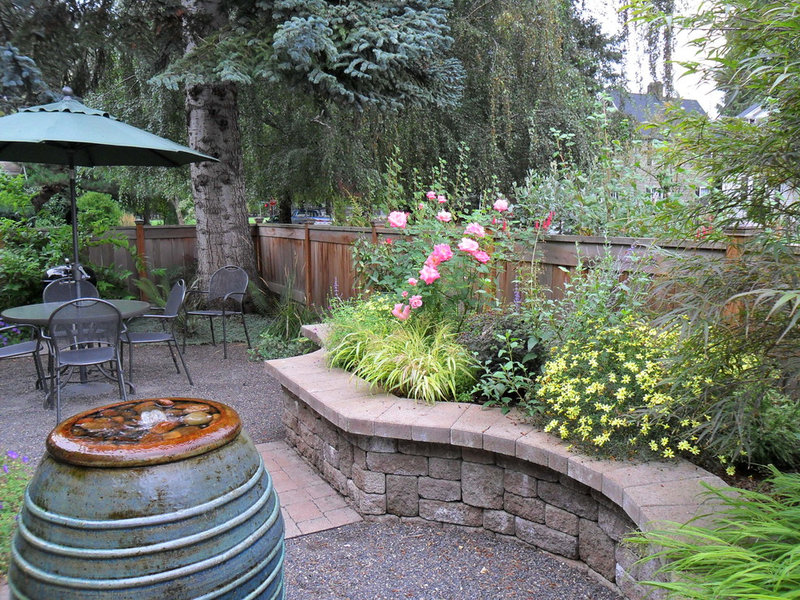 Plan-it Earth Design
5. Plant raised beds. If you’d prefer a more cohesive-looking garden than just an assortment of potted plants, you could essentially create one really big container that lifts your garden out of the muck and within easy reach — a raised bed. Though usually built with rectangular frames made of lumber, raised beds can be as fancy as you want them to be, just as long as they’re solidly built for safety.
Plan-it Earth Design
5. Plant raised beds. If you’d prefer a more cohesive-looking garden than just an assortment of potted plants, you could essentially create one really big container that lifts your garden out of the muck and within easy reach — a raised bed. Though usually built with rectangular frames made of lumber, raised beds can be as fancy as you want them to be, just as long as they’re solidly built for safety. Even if you don’t plan to build a raised bed, you can still build up the soil by amending it with organic matter such as compost.
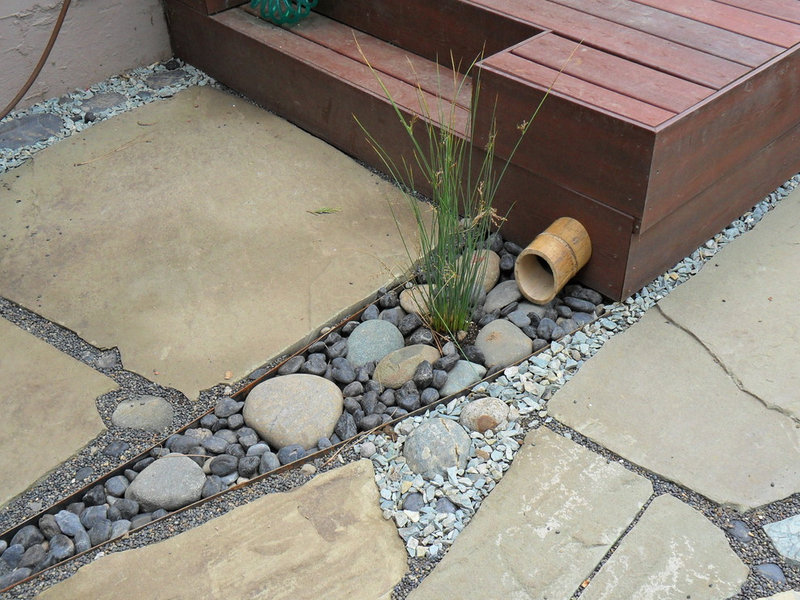 Plan-it Earth Design
6. Give your downspout a makeover. Fountains and waterfalls are popular for the soothing sounds and movement they bring to landscapes, but they can be costly — not to mention a lot of work. Instead, consider utilizing those overlooked downspouts, turning them into a natural water feature that follows nature’s rhythms without adding to your utility bill. Use PVC pipe to collect the water from the gutters and choose an attractive facade for the downspout. The bamboo used here lends an Asian look along with the natural arrangement of rocks, and a single plant is enough to imply the existence of water even in between rains.
Plan-it Earth Design
6. Give your downspout a makeover. Fountains and waterfalls are popular for the soothing sounds and movement they bring to landscapes, but they can be costly — not to mention a lot of work. Instead, consider utilizing those overlooked downspouts, turning them into a natural water feature that follows nature’s rhythms without adding to your utility bill. Use PVC pipe to collect the water from the gutters and choose an attractive facade for the downspout. The bamboo used here lends an Asian look along with the natural arrangement of rocks, and a single plant is enough to imply the existence of water even in between rains.
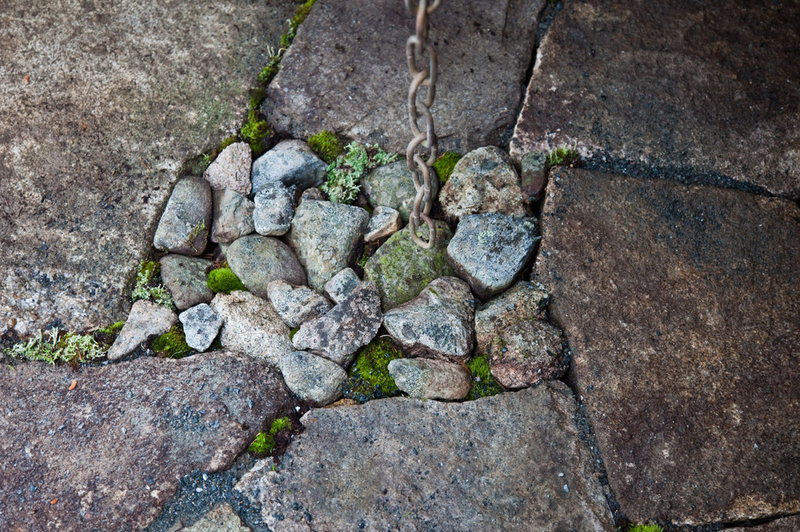 Matthew Cunningham Landscape Design LLC
7. Hang a rain chain. Another way to make the most of all that roof runoff involves replacing the downspout with a rain chain; a series of links or cups that channels rainwater attractively as it plummets to the ground. Rain chains bring a touch of artistic whimsy to a garden, to be sure, but they’re all the more appealing for their ability to slow the flow of water from the roof. This helps reduce erosion and increases the likelihood that the moisture will be soaked up by the soil before it drains away from your plants.
Matthew Cunningham Landscape Design LLC
7. Hang a rain chain. Another way to make the most of all that roof runoff involves replacing the downspout with a rain chain; a series of links or cups that channels rainwater attractively as it plummets to the ground. Rain chains bring a touch of artistic whimsy to a garden, to be sure, but they’re all the more appealing for their ability to slow the flow of water from the roof. This helps reduce erosion and increases the likelihood that the moisture will be soaked up by the soil before it drains away from your plants.
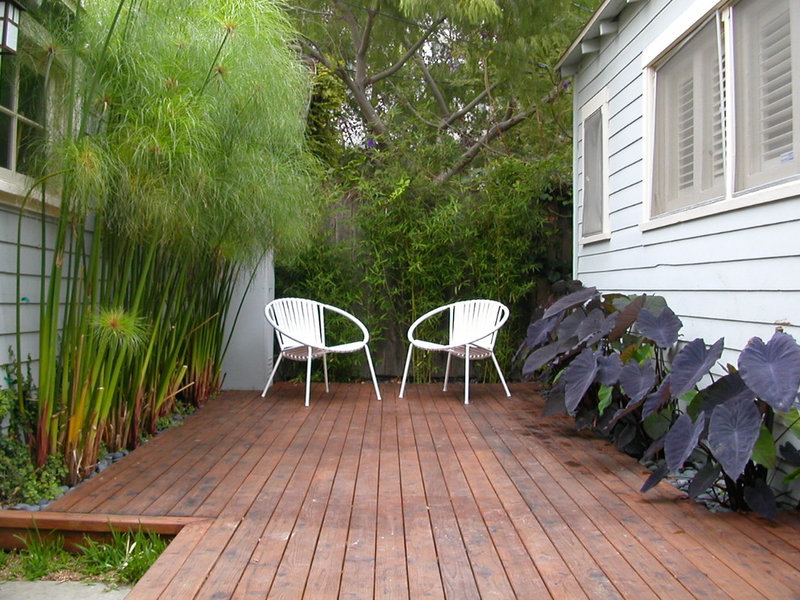 Paradise Design Studio
8. Add a deck. A rain garden is fine and dandy, unless the soggy site in question receives a lot of foot traffic. If that’s the case, the first thing you should do is use the methods outlined above to drain water away from your house’s foundation. Then construct a deck that will allow you to enjoy your lush and watery garden without getting your shoes all muddy in the process. Wood planks may also be used to replace your puddly paths with boardwalks and bridges. Not only is this practical, but it really elevates the look of your garden and makes it much more inviting to guests. To keep them from accidentally walking off the ledge, install lighting to illuminate the way and include guardrails where the deck sits 30 inches or more off the ground.
Paradise Design Studio
8. Add a deck. A rain garden is fine and dandy, unless the soggy site in question receives a lot of foot traffic. If that’s the case, the first thing you should do is use the methods outlined above to drain water away from your house’s foundation. Then construct a deck that will allow you to enjoy your lush and watery garden without getting your shoes all muddy in the process. Wood planks may also be used to replace your puddly paths with boardwalks and bridges. Not only is this practical, but it really elevates the look of your garden and makes it much more inviting to guests. To keep them from accidentally walking off the ledge, install lighting to illuminate the way and include guardrails where the deck sits 30 inches or more off the ground.
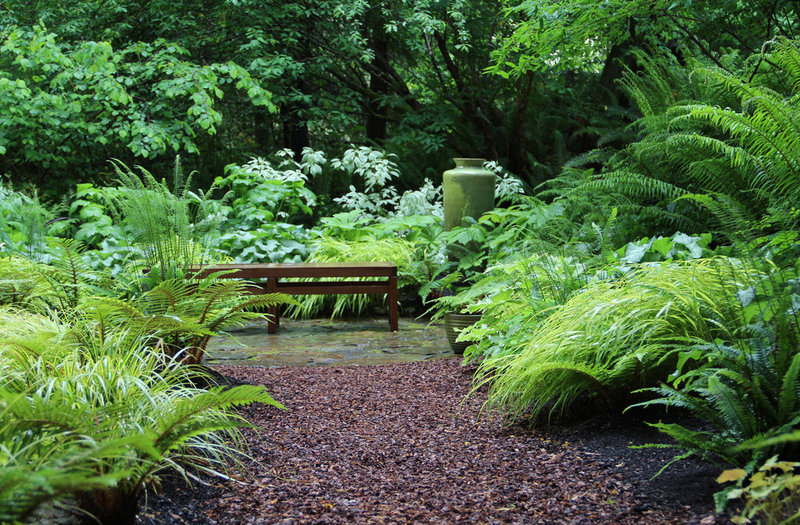 Bliss Garden Design
9. Replace mud with gravel. Decks or boardwalks are worthwhile investments, to be sure, but they aren’t for everyone, and the costs can certainly add up. Luckily you can also solve the puddle problem by laying paths and patios with gravel, pavers and stone. An especially attractive solution is to lay large pavers or flagstones with gravel or stones filling the spaces between. This has slows people’s paces as they step over the gaps, and it also gives water a place to permeate and drain away. Permeable bricks and pavers are good solutions for driveways and patios, because they provide solid footing while allowing water to drain through the gaps.
Bliss Garden Design
9. Replace mud with gravel. Decks or boardwalks are worthwhile investments, to be sure, but they aren’t for everyone, and the costs can certainly add up. Luckily you can also solve the puddle problem by laying paths and patios with gravel, pavers and stone. An especially attractive solution is to lay large pavers or flagstones with gravel or stones filling the spaces between. This has slows people’s paces as they step over the gaps, and it also gives water a place to permeate and drain away. Permeable bricks and pavers are good solutions for driveways and patios, because they provide solid footing while allowing water to drain through the gaps.
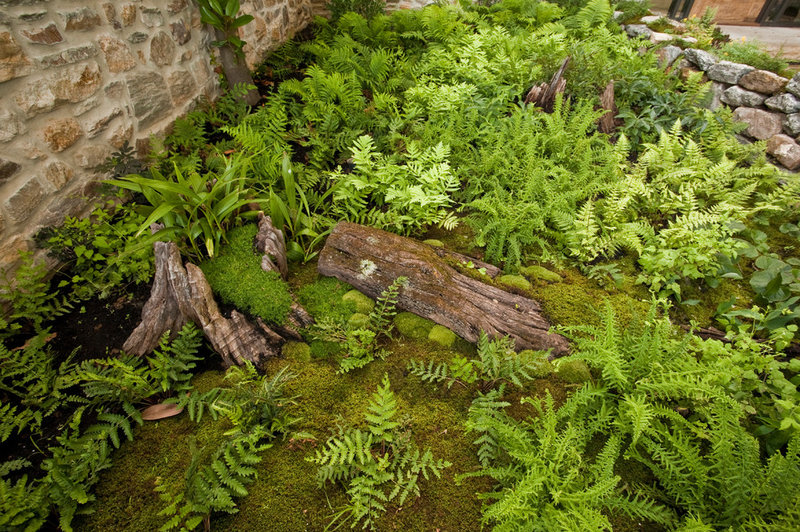 ZH Design
10. Lose the Gainesville lawn and say hello to moss. Finally, I would like to encourage you to make friends with moss. It’s soft, treadable and easy to establish as an alternative to turfgrasses in areas where it’s too shady or wet for them to grow; but mostly you should try growing moss because of the profound beauty it brings to whatever it envelops. Most wet sites already have colonies of moss hiding under the weeds, but you can help it get the upper hand by removing the weeds, dividing and pinning the moss to the ground, and watering it until established. Moss is notoriously slow growing, but you can get a head start by purchasing some from Moss Acres or Moss and Stone Gardens.
ZH Design
10. Lose the Gainesville lawn and say hello to moss. Finally, I would like to encourage you to make friends with moss. It’s soft, treadable and easy to establish as an alternative to turfgrasses in areas where it’s too shady or wet for them to grow; but mostly you should try growing moss because of the profound beauty it brings to whatever it envelops. Most wet sites already have colonies of moss hiding under the weeds, but you can help it get the upper hand by removing the weeds, dividing and pinning the moss to the ground, and watering it until established. Moss is notoriously slow growing, but you can get a head start by purchasing some from Moss Acres or Moss and Stone Gardens.

